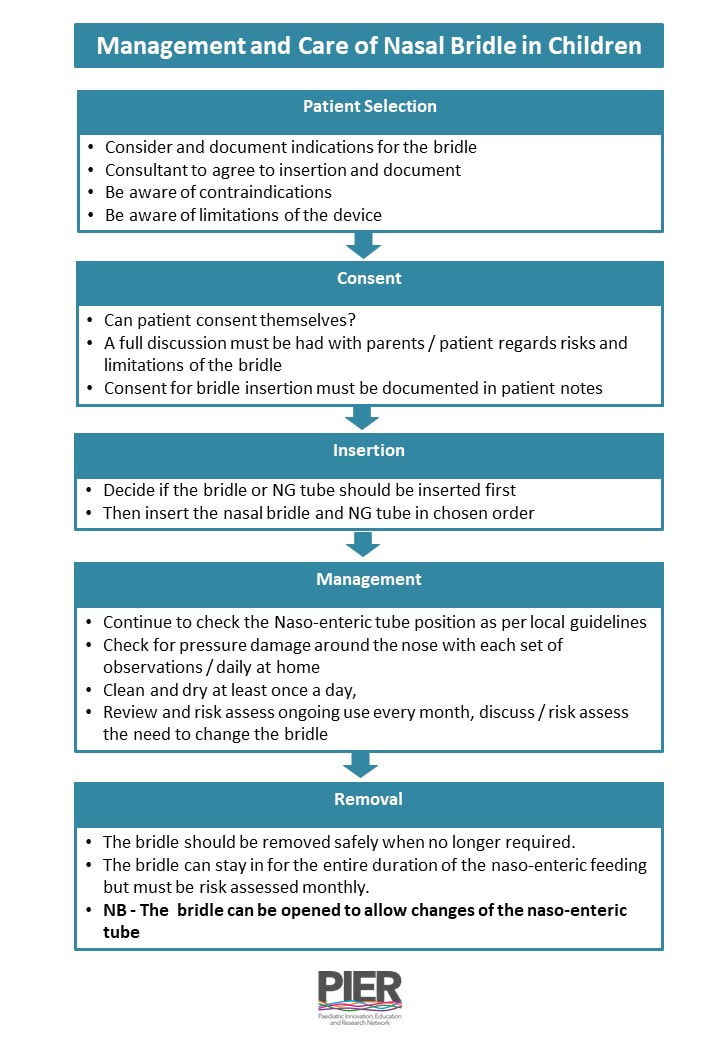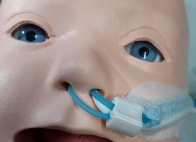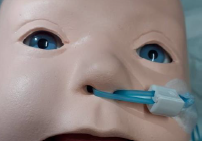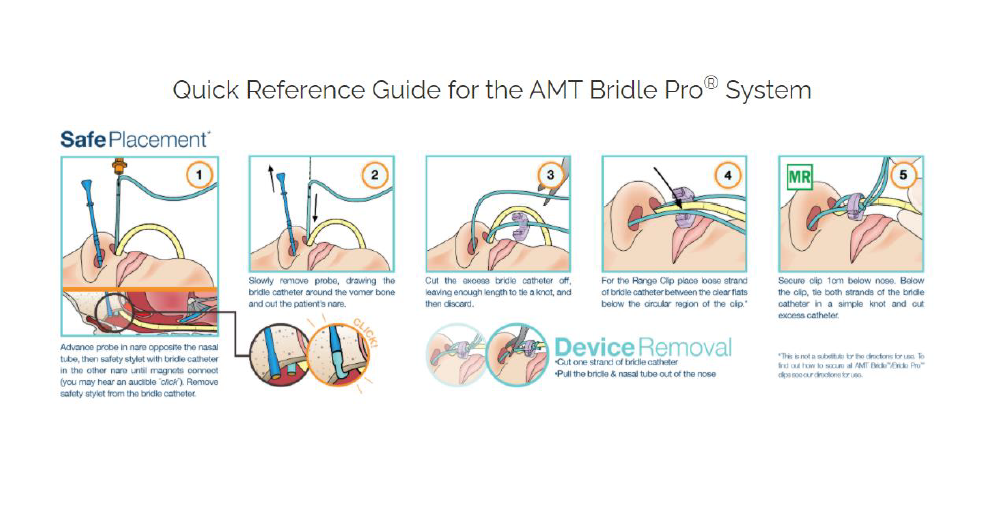- Home
- Guidelines
- Innovation
-
Education
- Study Days & Courses
- STAR Simulation App
- Faculty Resources
- Videos >
- Respiratory Videos (High flow, Tracheostomies, Chest drains, and sleep studies)
- Speciality Training Resources
- Paediatric Long Term Ventilation Team
- Life Support Resources
- #PedsCards Against Humanity
- Bronchiolitis Surge Resources
- Other Educational Opportunities
- Research
- Conference
-
Trainees
- Preceptorships
-
Networks
- Wessex Children's and Young Adults' Palliative Care Network
- PREMIER - Paediatric Regional Emergency Medicine Innovation, Education & Research Network
- Wessex Allergy Network
- Wessex Paediatric Endocrine Network
- Wessex Diabetes Network
- Clinical Ethics >
- TV and Wessex Neonatal ODN
- Regional Referrals to Specialist Services >
- Search
Management and Care of a Nasal Bridle in Children
Introduction
Naso-enteric tubes are the most commonly placed tubes for enteral feeding. However, they are frequently displaced or pulled out which may lead to delays in delivering adequate nutrition.
Repeated attempts to re-insert the feeding tube can cause nasopharyngeal trauma and can lead to prolonged periods without nutrition. In some instances, repetitive problems with naso-enteric tube displacement may also lead to an early referral for insertion of a gastro/gastrojejunostomy tube.
Many dressings have been used for securing naso-enteric tubes to prevent accidental or deliberate displacement in patients. Adhesive tape can be ineffective or painful for the patient and can result in skin damage.
A manufactured naso-enteric tube retention device (AMT Bridle) is available and can be placed as an outpatient procedure by registered practitioners.
This document describes the use of the AMT Bridle in children for the fixation of naso-enteric feeding tubes – where naso-gastric (NG) is mentioned in the document it can also apply to naso-jejunal (NJ) tubes.
Repeated attempts to re-insert the feeding tube can cause nasopharyngeal trauma and can lead to prolonged periods without nutrition. In some instances, repetitive problems with naso-enteric tube displacement may also lead to an early referral for insertion of a gastro/gastrojejunostomy tube.
Many dressings have been used for securing naso-enteric tubes to prevent accidental or deliberate displacement in patients. Adhesive tape can be ineffective or painful for the patient and can result in skin damage.
A manufactured naso-enteric tube retention device (AMT Bridle) is available and can be placed as an outpatient procedure by registered practitioners.
This document describes the use of the AMT Bridle in children for the fixation of naso-enteric feeding tubes – where naso-gastric (NG) is mentioned in the document it can also apply to naso-jejunal (NJ) tubes.
Scope and Purpose
This guideline is for use by all registered healthcare professionals that provide care for children who may require a nasal bridle:
To aid the use of nasal bridles in the prevention of accidental displacement of naso-enteric feeding tubes from patients:
- To prevent the inappropriate use of nasal bridles in children and infants under 18 years old.
To aid the use of nasal bridles in the prevention of accidental displacement of naso-enteric feeding tubes from patients:
- To maximise optimal nutrition.
- To minimise suffering by avoiding repeated insertions of naso-enteric tubes.
- To minimise complications of multiple insertions of naso-enteric tubes.
- To avoid unnecessary gastrostomy/jejunostomy tube placement
- To minimise the need for parenteral nutrition.
- To reduce the risk of patients missing medication
- To minimise the number of IV cannula for fluid replacement.
Definitions
Nasal Bridle
A naso-enteric tube retention device that passes a loop of silicone behind the nasal septum and exits from each nostril. A retaining clip then secures the naso-enteric tube to the silicone loop.
Nasal Bridle kit
The kit contents include:
Retaining clip
The name given to the clip supplied with the Bridle kit. This is size specific according to the size of the nasal tube being used.
A naso-enteric tube
A tube that is inserted through the nose, down the back of the pharynx, and into the stomach or small bowel. They are used to provide enteral nutrition or allow drainage of the stomach in selected patients.
Plectrum
A device that can be used to open the retaining clip
Naso-enteric
A fine bore tube that passes down the nose into the gastrointestinal tract
NG tube
Naso-gastric tube
NJ tube
Naso-jejunal tube
TA tube
Trans-anastomotic tube
A naso-enteric tube retention device that passes a loop of silicone behind the nasal septum and exits from each nostril. A retaining clip then secures the naso-enteric tube to the silicone loop.
Nasal Bridle kit
The kit contents include:
- A ‘retrieval probe’
- Catheter with attached tape and stylet guide
- Feeding tube retaining clip.
- Plectrum
Retaining clip
The name given to the clip supplied with the Bridle kit. This is size specific according to the size of the nasal tube being used.
A naso-enteric tube
A tube that is inserted through the nose, down the back of the pharynx, and into the stomach or small bowel. They are used to provide enteral nutrition or allow drainage of the stomach in selected patients.
Plectrum
A device that can be used to open the retaining clip
Naso-enteric
A fine bore tube that passes down the nose into the gastrointestinal tract
NG tube
Naso-gastric tube
NJ tube
Naso-jejunal tube
TA tube
Trans-anastomotic tube
Guideline
Patient Selection
Every child that is to have a bridle inserted at Southampton Children’s Hospital must have a “Bridle insertion referral form” via eQuest. A sample referral form for use outside of Southampton Children’s Hospital (DGH or Community) can be found as Appendix A.
Contraindications
Limitations of bridle
Procedure for the insertion of the nasal bridle
This is not an emergency procedure and should be completed within working hours as multiple staff available for support in the event of a difficult placement.
A Bridle the same French as the NG tube in situ must be used
Please follow manufacturers’ instruction. See Appendix B
Staff should be appropriately trained before unsupervised placement. Appendix C should be used to record training.
Management of the nasal bridle
Please follow manufacturers’ instruction. A patient information leaflet can be found in Appendix D.
If the family chose to tape the tube to the cheek the tube must be left loose and not pulled tightly to one side as this can cause pressure damage to the soft tissue of the nose.
- Patients that have inadvertently removed at least 2 or more naso-enteric tubes within a 48-hour period (documented evidence in medical notes)
- Patients with underlying health conditions that require hospitalisation to place an NG tube, for example patients that require advanced monitoring, oxygen and suction during insertion.
- Patients who are pulling at other types of devices, e.g., urinary catheters, intravenous cannula or have shown previous significant distress with naso-enteric tube placements.
- Elective use to retain NJ/TA tubes which are considered difficult to replace or a technically difficult procedure (NJ bedside placement, endoscopically or radiologically).
Every child that is to have a bridle inserted at Southampton Children’s Hospital must have a “Bridle insertion referral form” via eQuest. A sample referral form for use outside of Southampton Children’s Hospital (DGH or Community) can be found as Appendix A.
Contraindications
- Premature babies as the vomer bone is not fully matured
- Patients with:
- Nasal airway obstruction
- Nasal abnormalities
- Facial or cranial fractures
Limitations of bridle
- The bridle will not prevent displacement if significant traction is placed on the tube, for example if the connector of NG tube is caught in the bed and the child is moved.
- It will not stop a child who is actively determined to remove their tube on purpose.
- It will not stop displacement of the tip of NJ tube due to vomiting or reverse peristalsis
Procedure for the insertion of the nasal bridle
This is not an emergency procedure and should be completed within working hours as multiple staff available for support in the event of a difficult placement.
A Bridle the same French as the NG tube in situ must be used
Please follow manufacturers’ instruction. See Appendix B
Staff should be appropriately trained before unsupervised placement. Appendix C should be used to record training.
Management of the nasal bridle
Please follow manufacturers’ instruction. A patient information leaflet can be found in Appendix D.
If the family chose to tape the tube to the cheek the tube must be left loose and not pulled tightly to one side as this can cause pressure damage to the soft tissue of the nose.
Changing the NG tube
This can be achieved with the bridle still in situ. Use the plectrum, which is supplied and open the clip as shown in Appendix E. Change the NG tube as per local policy and re-secure the clip around the new tube.
Removal of the nasal bridle and NG tube
To remove the AMT Bridle and the tube: Cut only ONE strand of the umbilical tape. Gently pull both the Bridle and nasal tube out of the nose.
This can be achieved with the bridle still in situ. Use the plectrum, which is supplied and open the clip as shown in Appendix E. Change the NG tube as per local policy and re-secure the clip around the new tube.
Removal of the nasal bridle and NG tube
To remove the AMT Bridle and the tube: Cut only ONE strand of the umbilical tape. Gently pull both the Bridle and nasal tube out of the nose.
Appendix A - Bridle Insertion Referral Form
Appendix C - Training Competency Document for Parents and Carers
Appendix D - Patient Information Leaflet
References
- Quick Reference Guide for the AMT Bridle Pro® System, 2021, https://www.appliedmedical.net/enteral/bridle/
- Fearon (1998) Assessment and Measurement of Competence in Practice. Nursing Standard Feb 1998 Vol.12 No 22
- National Patient Safety Alert (2005) & (2011) Reducing harm caused by the misplacement of nasogastric feeding tubes in Adults, Children and Infants.
- National Patient Safety Alert (2016) Nasogastric tube misplacement: continuing risk of death and severe harm.
- Belden, C.J., Mancuso, A.A., & Kotzur (1997). The developing anterior skull base: CT appearance from birth to 2 years of age. American Journal of Neuroradiology, 18, 811-818
- Kang, K et al. 2018. Nasal Bridling of Nasoenteric Feeding Tubes, Implementation Program in the Pediatric Surgical Population Less Than 1 Year Old. Journal of Pediatric Surgical Nursing: 7. Issue 1 (p29-33)
|
Document Version:
1.0 Lead Authors: Rhoda Taylor & Karen Dick (Paediatric Surgical Nurse Specialists) |
Approving Network:
Wessex Paediatric Gastroenterology Network Date of Approval: October 2021 Review Due:
October 2024 |
PIER Contact |
|
- Home
- Guidelines
- Innovation
-
Education
- Study Days & Courses
- STAR Simulation App
- Faculty Resources
- Videos >
- Respiratory Videos (High flow, Tracheostomies, Chest drains, and sleep studies)
- Speciality Training Resources
- Paediatric Long Term Ventilation Team
- Life Support Resources
- #PedsCards Against Humanity
- Bronchiolitis Surge Resources
- Other Educational Opportunities
- Research
- Conference
-
Trainees
- Preceptorships
-
Networks
- Wessex Children's and Young Adults' Palliative Care Network
- PREMIER - Paediatric Regional Emergency Medicine Innovation, Education & Research Network
- Wessex Allergy Network
- Wessex Paediatric Endocrine Network
- Wessex Diabetes Network
- Clinical Ethics >
- TV and Wessex Neonatal ODN
- Regional Referrals to Specialist Services >
- Search




